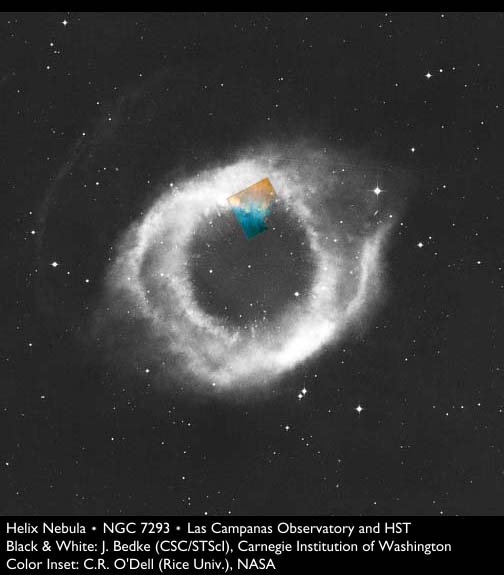5. INSTABILITY, MASS LOSS, AND PLANETARY NEBULAE
The most luminous stars are not very stable. Their luminosities are so great that the outward force exerted by the escaping radiation is almost equal to the gravitational force that holds the star together. As a result, blue giant stars lose mass from their outer envelopes in powerful stellar winds having huge (500 - 3000 km/s) velocities. According to theory, a main sequence star with mass greater than about 200 solar masses can't exist. If a star with greater mass begins to form, it will blow itself apart as soon as it begins to burn hydrogen in its core.
|
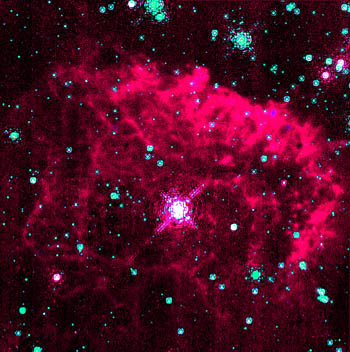
|
|
The most luminous star known (about 107 times the Sun). Astronomers think that this star might have been born with a mass of 200 solar masses and has already expelled half its mass into interstellar space. The red gas is hydrogen expelled by the star at a speed of a few hundred kilometers/second. |
In 1997, astronomers from UCLA, using a new infrared camera on the Hubble Space Telescope, discovered the current record holder, which is shown above. You can read more about this discovery here.
Red giant stars tend to be even more unstable than blue giant stars, because they are so distended that gravity has a relatively feeble hold on their outer atmospheres. Moreover, their enormous luminosity pushes the envelope outward. As a result, every red giant star is losing mass in stellar winds. The outer part of the star is literally blowing out into interstellar space, at velocities ranging from 10 to 30 km/s -- huge by Earth standards but not so fast by interstellar standards. The mass loss rate in these stellar winds is so great that the star can lose more than half of its total mass during its red giant phase.
|
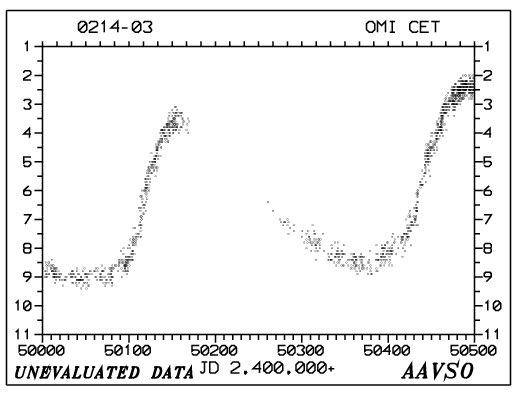
|
|
Light curve of the variable red giant star Mira (also called Omicron Ceti). The brightness varies by more than 6 magnitudes from minimum to maximum -- a factor of greater than 250 -- over a period of about a year. |
Some of the most luminous red giant stars become brighter and dimmer over periods of a year or so. These are called "long period variables", or "Mira Variables", named after the star Mira described above.
|
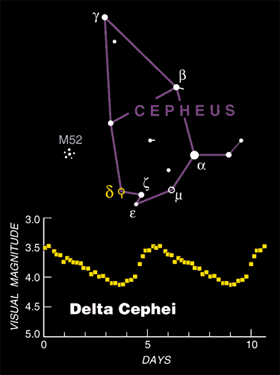
|
|
The star Delta Cephei, the 4th brightest star in the Constellation Cepheus, varies in brightness by about 0.7 visual magnitudes (a factor of about 2) with a regular period of about 5 days. It is the prototype of a class of stars called Cepheid variables. Source |
Many horizontal branch stars pulsate regularly. The more luminous ones, resulting from the evolution of stars considerably more massive than the Sun, are called Cepheid variables. They pulsate regularly with periods ranging from 1 to 100 days. The less luminous ones are called RR Lyrae stars. These stars regularly become brighter and dimmer as their radius swells up and shrinks back down, as illustrated in this Cepheid variable animation. As we shall see later, these variable stars are very important for determining cosmic distances because astronomers can infer their luminosities by observing their pulsation periods.
Observations of variable stars are important for many reasons. Some stars vary because they are eclipsing binaries, others because they are pulsating. Many can be observed with relatively small telescopes, and amateur astronomers have made important contributions to our knowledge of these systems by carefully observing their light curves. You can find the light curves of many different kinds of variable stars at the American Association of Variable Star Observers and at Hipparcos Variable Stars.
AGB stars are even more unstable than red giants. Toward the ends of their lifetimes, they are likely to expel almost all their hydrogen and helium envelope into interstellar space, leaving a glowing shell of gas called a planetary nebula. This animation illustrates the birth of the Helix Nebula. The animation begins with a big red AGB star that is ejecting its distended outer envelope into interstellar space at relatively low velocity. When most of the outer envelope is gone, the hot luminous carbon/oxygen core of the star is exposed. This star has a fast low-density wind that blows a big cavity in the dispersed stellar envelope. Ultraviolet radiation from the star heats the gas, causing it to glow. (The name planetary nebula is a misnomer. Planetary nebulae have nothing to do with planetary systems. But the astronomers who first observed them thought they might be the sites of planet formation, and the name stuck.)
Planetary nebulae are among the most beautiful objects in the
sky. Some are fairly smooth and symmetrical, such as the famous Ring
Nebula in Lyra (source)
(a.k.a. M57), which you can see easily through the telescopes at the Sommers-Bausch
Observatory. Many planetary nebulae have strange and wonderful shapes, indicating
that the mass ejection process is very complicated. Probably, many planetary
nebulae come from close binary stars, in which the gas outflow is influenced
by the interactions between the stars. Here are three interesting places to
find different kinds of images of planetary nebulae: You can find images of
several planetary and other kinds of nebulae in the following places: Hubble
Space Telescope; Chandra;
VLT.
UPDATE, FEBRUARY 21, 2001:
The Chandra team released a wonderful composite image (below) of a planetary
nebula called the Cat's Eye. The image on the left shows X-rays (rendered in
orange) emitted by the central star and hot (> 106 K) gas inside
the nebula. The image on the right is a composite of the optical emission seen
by the Hubble Space Telescope (in actual colors), with the same X-ray image
as on the left but now rendered in blue.
|
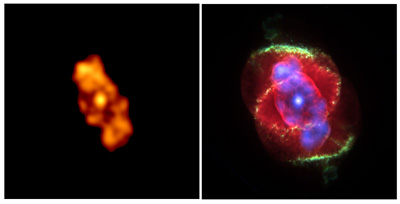
|
|
The Cat's Eye Planetary Nebula as seen by HST and Chandra. See Press Release. |
A planetary nebula does not last very long by stellar evolution standards. Within 100,000 years, the surrounding gas will be dispersed into interstellar space and the central star will become too cool to emit enough ultraviolet radiation to cause the gas to glow.
The central stars of planetary nebulae are composed mostly of carbon and oxygen. They are very hot and fairly luminous but they are not burning -- i.e., no nuclear reactions are occurring within them to replace the energy that is being lost to radiation. They will cool and shrink, becoming much dimmer. These dying embers of stellar evolution are called white dwarf stars. We describe them in the following section.
(Return to course home page)
Last modified February 13, 2002
Copyright by Richard McCray


